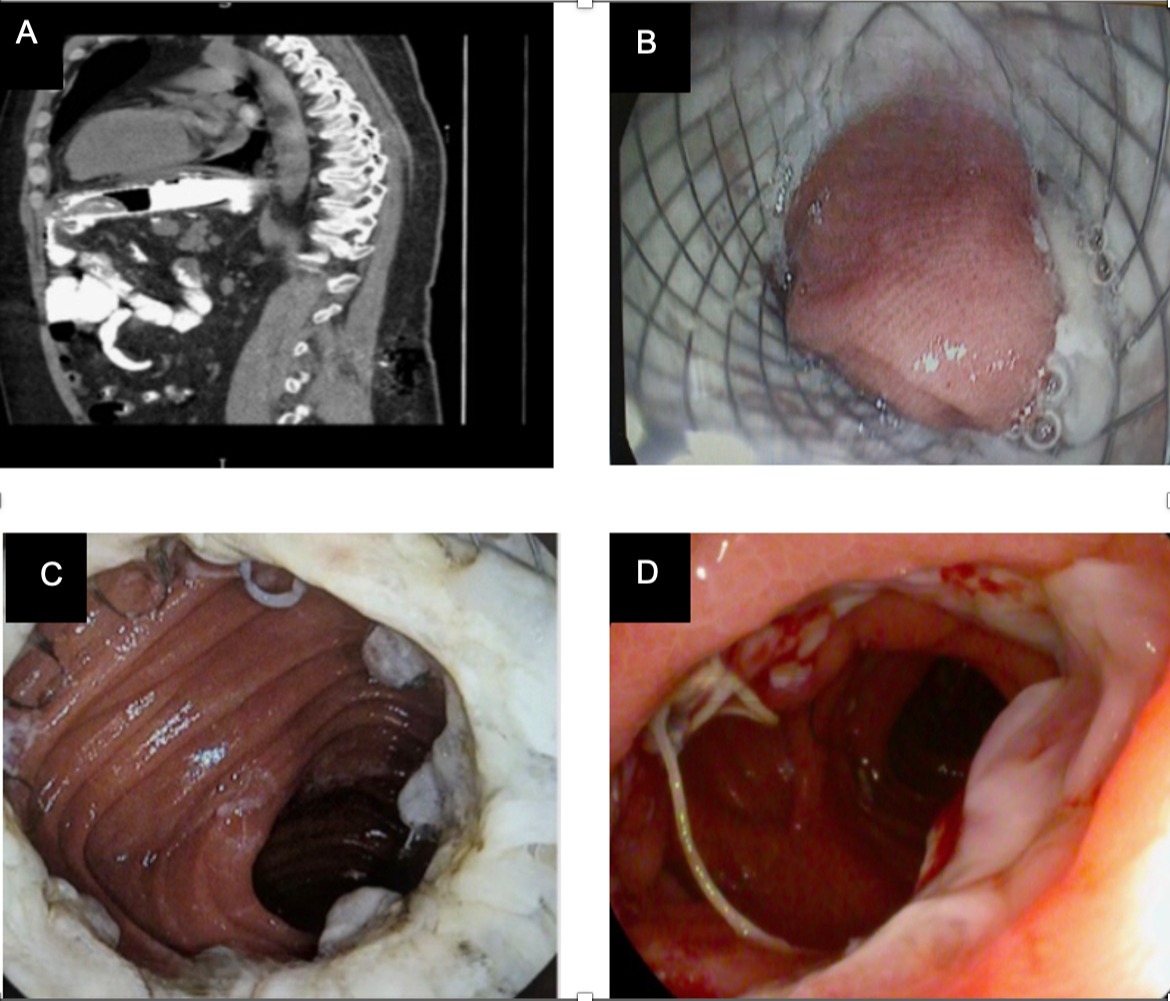Monday Poster Session
Category: Interventional Endoscopy
P2307 - A Rare Case of Retrograde Intussusception into Gastrojejunal (GJ) Stent After a Revisional Roux-en-Y Gastric Bypass
Monday, October 23, 2023
10:30 AM - 4:15 PM PT
Location: Exhibit Hall

Has Audio

Rami Musallam, MD
University Hospitals Cleveland Medical Center
Cleveland, OH
Presenting Author(s)
Rami Musallam, MD1, Pearl Aggarwal, MD2, Vivek Kumbhari, MBBCh, PhD3, Fazel Dinary, MD2
1University Hospitals Cleveland Medical Center, Cleveland, OH; 2University Hospitals St. John Medical Center, Westlake, OH; 3Mayo Clinic, Jacksonville, FL
Introduction: Intussusception after Roux-en-Y gastric bypass (RYGB) is a rare postoperative complication, with the jejune-jejunal being the most common type. Only 5 cases of jejunogastric intussusception have been reported worldwide. We present a case of retrograde intussusception into gastrojejunal (GJ) stents in revisional RYGB.
Case Description/Methods: A 51-year-old Caucasian male with a history of the gastric sleeve with a conversion to Roux-en-Y gastric bypass for weight regain complicated with staple line leak, managed with 23mm x 125mm fully covered stent at the GJ anastomosis, presented two days later with sharp epigastric pain and vomiting. The exam was notable for epigastric tenderness. A computed tomography scan of the abdomen with oral contrast revealed a high-grade intussusception at the GJ stent level. Esophagogastroduodenoscopy initially showed a patent stent; further in the exam, intermittent jejunal intussusception into the GJ stent was noted. The endoscope was advanced 30 cm beyond the distal stent tip without showing mucosal ulceration. The symptoms subsided after the endoscopy, and the stent was removed four weeks after the healing of the leak.
Discussion: Anastomotic leaks are serious complications of bariatric surgery. Due to significant morbidity and mortality, self-expandable metal stents (SEMSs) for managing post-bariatric surgery leaks are indicated as an alternative to revisional surgery. Intussusception after RYGB is an infrequent complication, with an incidence of 0.6%. It occurs at jejunojejunal (94.6%), jejunogastric (4.5%), and gastroduodenal (0.9%) sites. In the literature, 87% of the post-RYGB intussusception cases were retrograde, and 98% had no lead point on operative exploration. The suggested hypothesis includes staples or sutures as lead points, anatomical aberrations, or the coexistence of pacemaker cells at the Roux limb and normal duodenum, causing dysmotility. In our case, we believe the lead point was the stent. The diagnosis is best made by CT. EGD gives real-time anatomy, thus increasing diagnostic sensitivity. Complications include intestinal obstruction with ischemia, requiring emergent surgery. There is no consensus as to which treatment is optimal for intussusception after RYGB. Given the rarity of the condition, awareness of this complication is critical for prompt diagnosis and management. We believe this paper presents the first case of retrograde intussusception into GJ stent following a revisional RYGB.

Disclosures:
Rami Musallam, MD1, Pearl Aggarwal, MD2, Vivek Kumbhari, MBBCh, PhD3, Fazel Dinary, MD2. P2307 - A Rare Case of Retrograde Intussusception into Gastrojejunal (GJ) Stent After a Revisional Roux-en-Y Gastric Bypass, ACG 2023 Annual Scientific Meeting Abstracts. Vancouver, BC, Canada: American College of Gastroenterology.
1University Hospitals Cleveland Medical Center, Cleveland, OH; 2University Hospitals St. John Medical Center, Westlake, OH; 3Mayo Clinic, Jacksonville, FL
Introduction: Intussusception after Roux-en-Y gastric bypass (RYGB) is a rare postoperative complication, with the jejune-jejunal being the most common type. Only 5 cases of jejunogastric intussusception have been reported worldwide. We present a case of retrograde intussusception into gastrojejunal (GJ) stents in revisional RYGB.
Case Description/Methods: A 51-year-old Caucasian male with a history of the gastric sleeve with a conversion to Roux-en-Y gastric bypass for weight regain complicated with staple line leak, managed with 23mm x 125mm fully covered stent at the GJ anastomosis, presented two days later with sharp epigastric pain and vomiting. The exam was notable for epigastric tenderness. A computed tomography scan of the abdomen with oral contrast revealed a high-grade intussusception at the GJ stent level. Esophagogastroduodenoscopy initially showed a patent stent; further in the exam, intermittent jejunal intussusception into the GJ stent was noted. The endoscope was advanced 30 cm beyond the distal stent tip without showing mucosal ulceration. The symptoms subsided after the endoscopy, and the stent was removed four weeks after the healing of the leak.
Discussion: Anastomotic leaks are serious complications of bariatric surgery. Due to significant morbidity and mortality, self-expandable metal stents (SEMSs) for managing post-bariatric surgery leaks are indicated as an alternative to revisional surgery. Intussusception after RYGB is an infrequent complication, with an incidence of 0.6%. It occurs at jejunojejunal (94.6%), jejunogastric (4.5%), and gastroduodenal (0.9%) sites. In the literature, 87% of the post-RYGB intussusception cases were retrograde, and 98% had no lead point on operative exploration. The suggested hypothesis includes staples or sutures as lead points, anatomical aberrations, or the coexistence of pacemaker cells at the Roux limb and normal duodenum, causing dysmotility. In our case, we believe the lead point was the stent. The diagnosis is best made by CT. EGD gives real-time anatomy, thus increasing diagnostic sensitivity. Complications include intestinal obstruction with ischemia, requiring emergent surgery. There is no consensus as to which treatment is optimal for intussusception after RYGB. Given the rarity of the condition, awareness of this complication is critical for prompt diagnosis and management. We believe this paper presents the first case of retrograde intussusception into GJ stent following a revisional RYGB.

Figure: A: Computed tomography image of the intestinal telescoping into the stent; B: Endoscopic image of jejunal telescoping into the stent; C: Endoscopic image of the gastrojejunal anastomosis post reduction; D: Endoscopic image of the gastrojejunal anastomosis post stent removal
Disclosures:
Rami Musallam indicated no relevant financial relationships.
Pearl Aggarwal indicated no relevant financial relationships.
Vivek Kumbhari indicated no relevant financial relationships.
Fazel Dinary indicated no relevant financial relationships.
Rami Musallam, MD1, Pearl Aggarwal, MD2, Vivek Kumbhari, MBBCh, PhD3, Fazel Dinary, MD2. P2307 - A Rare Case of Retrograde Intussusception into Gastrojejunal (GJ) Stent After a Revisional Roux-en-Y Gastric Bypass, ACG 2023 Annual Scientific Meeting Abstracts. Vancouver, BC, Canada: American College of Gastroenterology.
